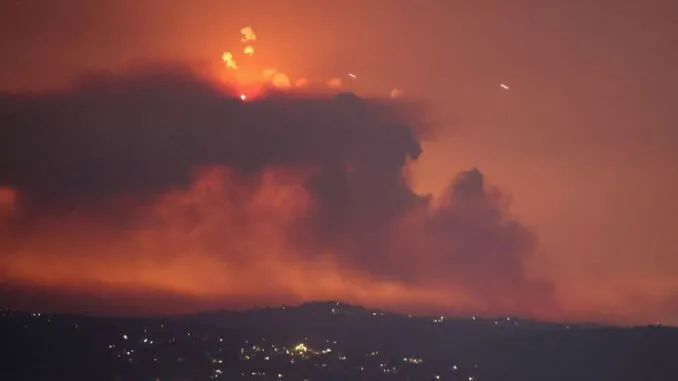In a dramatic escalation of hostilities, Israel has ramped up its military operations in southern Lebanon, launching airstrikes that included one of the largest bombs the country has ever deployed. This surge in violence follows renewed conflict with Hezbollah, resulting in a devastating exchange of fire over the weekend. With Israel's military announcing new objectives aimed at securing Northern Israel, the situation has intensified, raising concerns over a potential all-out war in the region.
After announcing a new phase to the war, Israel unleashed hell on South Lebanon hitting them with a giant mystery bomb, one of the largest they’ve ever used.
Israeli jets have been pounding Hezbollah positions through much of Saturday.
ZeroHedge reports: Al Jazeera correspondents have confirmed that “Israel’s military launched 400 attacks on Lebanon on Saturday and Hezbollah fired rockets at the Ramat David base near the city of Haifa, in their largest exchange of fire since the war on Gaza began.”
Another indicator of the escalation is that Israel is apparently beginning use much bigger bombs compared to much of the past nearly year of internecine fighting. The below widely circulating footage shows a large flash and skyscraper-size fireball, resulting in some viewers speculating it was likely a heavy bunker-buster bomb, or possibly even a tactical nuke of some sort. Whatever it was, there’s never been anything like it used on Lebanon (that we know about).
IDF leadership on Saturday announced that new war goals in Lebanon include making it safe for tens of thousands of Israelis to return to their homes in the north again.
More unconfirmed footage:
* * *
Since Thursday and the deadly chaos of the two-day pager explosion attack, southern Lebanon has seen the most intense exchange of fire between Hezbollah and Israel since the conflict began after Oct.7.
On Saturday the expanded pace of fire has continued, with Hezbollah having launched at least 90 rockets on northern Israel, and the IDF saying it has mounted at least 80 raids on weapons installations belonging to Hezbollah.
 |
| (Funerals for victime of pager attacks, via AP) |
The Israeli army described that it “dismantled approximately 180 targets and thousands of launcher barrels” in southern Lebanon over several hours of Saturday.
But it also confirmed that “approximately 90 projectile launches were identified crossing from Lebanon into Israeli territory.” The IDF added: “The [Israeli military] will continue operating to dismantle and degrade Hezbollah’s capabilities and terror infrastructure.”
There are currently many warnings from both sides of the border that this marks a slide into all-out war, which both have avoided thus far, with the past year witnessing ‘limited’ and often short-lived attacks and rocket volleys.
The death toll from Friday’s Israeli airstrike which killed Hezbollah special forces commander Ibrahim Aqil has risen to 37, after a day-long rescue operation and workers picking through rubble of a residential building, according to the country’s Health Ministry. Reports say that a meeting of Hezbollah leaders was taking place in either a garage, or a tunnel underneath the building in south Beirut.
“According to source, the meeting was being held in a tunnel under a residential building, a location that was being used for the first time, which has raised Hezbollah’s concerns about the extent Israel has infiltrated its ranks,” Middle East Eye reports. Hezbollah has since confirmed that 16 of its members were killed in the attack.
Lebanon’s government says three children and seven women were among the victims. Over 60 others were injured. The White House has still called the Israeli strike “a good outcome”.
As of September 2024, the conflict remains highly volatile, with both sides on high alert for further escalation. Reports indicate that Israel's strategy now includes targeting Hezbollah's infrastructure more aggressively, while Hezbollah continues to respond with rocket fire into northern Israel. The international community is closely monitoring the situation, as tensions grow and civilian casualties rise, prompting calls for restraint from various global leaders.
